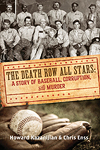
The Death Row All Stars: A Story of Baseball, Corruption and Murder, by Howard Kazanjian and Chris Enss, TwoDot, an imprint of Globe Pequot Press, Guilford, Conn., 2014, $16.95
It was only a four-game season for the team of baseball-playing inmates at the Wyoming State Penitentiary in Rawlins during the summer of 1911, but the Death Row All Stars went undefeated and mostly behaved in a professional and gentlemanly manner. This was at a time (1910–19) when, as the authors point out in their introduction, “many players associated with the professional clubs had reputations as hooligans and ruffians or worse.” The players were also known as Alston’s All Stars, after Felix Alston, the new baseball-loving warden, who founded the team in May 1911. In the first team photo, the players wear their inmate numbers on the left-hand pockets of their shirts. It wasn’t until 1916 that the Cleveland Indians became the first major-league team to wear numbers on their uniforms (on the left sleeves). In another photo, taken after their first wins, the ball-playing convicts have lost the numbers and look sharp in matching uniforms and caps. In the midst of these criminal offenders sits team mascot Felix Vern Alston Jr., the warden’s son. Two of the players, first baseman Eugene Rowan and catcher James Powell, were black at a time when only white players were allowed in the major and minor leagues.
The Death Row All Stars were not all condemned men, but they were all convicted criminals, and the star player had been given the death penalty for murder. After the team’s first game on July 18—an 11–1 thumping of the Wyoming Supply Co. Juniors ball club—The Washington Post reported under the headline SLAYER SCORES HOME RUNS: “Joseph Seng, right fielder for the Alstons, is under sentence to be hanged. Seng made two home runs hit over the penitentiary wall. One of his hits cleared the bases, bringing in three others and scoring himself.” Team captain George Saban, who did not play because he was missing two fingers on each hand, had also been convicted of murder. The shortstop had been convicted of manslaughter, several players had been convicted of rape, a couple for grand larceny and so on. Alston had a storied career in law enforcement before he became warden, but at his new job he met with plenty of criticism from the likes of former warden Otto Gramm and U.S. Senator Francis E. Warren. For one thing, Alston often conferred with pal Saban on the baseball field and let the murderer have nearly free rein off the field (including entering Rawlins saloons to bet on the All Stars’ games using money given to him by the friendly warden). Saban was hardly alone in the illegal gambling game; some state officials might have been wagering on the team.
The dramatic crux of the story isn’t in the baseball games themselves but in the challenges presented to the warden’s baseball club by Gramm, Warren and arrogant prisoner Lorenzo Paseo, who was no fan of the national pastime and threatened to kill the warden and Seng. There was also the matter of Seng’s death sentence. The authors write, “[Many prisoners] believed that the only thing standing in the way of the immediate execution of the star ballplayer was his success on the baseball field.” If true, then playing ball was literally a matter of life and death for the slugger.
It was a season to remember for Seng, Saban and the other members of Alston’s All Stars, but the last inning came too soon. When the All Stars disbanded in 1911, that marked the end of official baseball games at the Wyoming State Penitentiary. “By the time the 1912 baseball season rolled around,” the authors note, “Warden Alston’s thoughts were more on keeping order at the facility than playing the game.” Readers will think of that short 1911 season at the Wyoming pen long after they finish this book. The writing/research team of Chris Enss and Howard Kazanjian has fielded a winner.
—Editor




